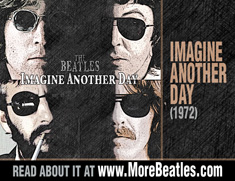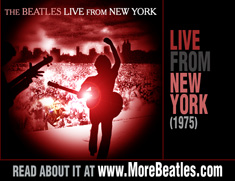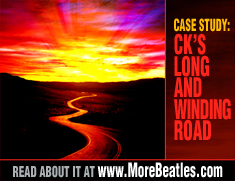
America had a new president in Gerald Ford, the Vietnam War was over, and the feeling that the Beatles had finished their jobs somehow seemed palpable. Although John Lennon and Paul McCartney had implied with the release of each of the last three albums that it would be their last together, a nearly universal recognition that Last Words really was the final album was emerging.
Despite all their public and private turmoil, Paul and John had always agreed on one thing since the summer of 1971. The wide acclaim and affection for George Harrison’s Concert for Bangladesh had proven that fans would embrace, and were probably starving for, a live album from the Beatles. At the same time, John also knew his immigration case was finally going to be decided one way or another. Either he would get his green card and be allowed to stay in New York, or he would lose his case and be summarily deported.
Suddenly, the unthinkable became thinkable. Paul had wanted to perform live again during the bad old days of Let It Be and Abbey Road, telling his mates, “Let’s get back to square one and remember what we’re all about.” John said he was daft and vetoed the plan in no uncertain terms. It appeared that the rooftop concert during Let It Be was as close as they would come to giving the fans what they clamored for. Before that, they’d not played together live as a group since 1966, nearly a decade earlier. But now, with his U.S. residency uncertain, John wanted what Paul wanted. George had already tasted success with a huge live show but was willing to share some of that excitement with his old friends, and Ringo was happy to go along.
The Apple PR machine ran with the big, good-news-bad-news nature of the announcement: The Beatles really, really meant that they would never record in the studio again, but they had agreed to play one live, blowout concert in order to say goodbye to fans in a final and more personal way. They would play to the largest crowd ever assembled in New York’s Central Park. And they would do it under a giant, symbolic, heavenly gesture of peace.
SAMPLE THE PLAYLIST!
♪ Listen to LIVE FROM NEW YORK on iTunes in the U.S.
♪ Listen to LIVE FROM NEW YORK on iTunes in Canada.
♪ Listen to LIVE FROM NEW YORK on iTunes in Europe.
♪ Listen to LIVE FROM NEW YORK on iTunes in Australia and New Zealand.
♪ Listen to LIVE FROM NEW YORK on iTunes in Mexico.
As it turned out, the Apollo-Soyuz link-up in space happened on July 17, when American commander Tom Stafford and Soviet commander Alexy Leonov exchanged a ballyhooed handshake after their two capsules got together hundreds of miles above the Earth. It was a gesture of detente between the two superpowers, and the Beatles decided to make it part of their mythology.
And so on Saturday night, July 19, the Beatles performed their last public concert with giant screens that displayed the famous handshake. Even Ringo, who’d gotten divorced from his wife Maureen just two days earlier, was in good spirits.
A documentary produced from this event eclipsed Let It Be in all respects: size, execution and emotion. Rather than the sadness seen in that other concert/documentary, Live From New York had resignation from both the Beatles and their fans, but also a sense of completion. And, most importantly, everyone knew it was a one-of-a-kind event, never to be repeated, and they behaved — more or less — appropriately.
 The phrase “Live from New York†was first famously used by Eric Clapton who introduced the Beatles that warm July evening in Central Park with, “Live from New York, it’s the Beatles!†Less than three months later, the cheeky new NBC sketch comedy series Saturday Night Live made the introduction its own.
The phrase “Live from New York†was first famously used by Eric Clapton who introduced the Beatles that warm July evening in Central Park with, “Live from New York, it’s the Beatles!†Less than three months later, the cheeky new NBC sketch comedy series Saturday Night Live made the introduction its own.
The party got started with McCartney’s “Band on the Run,†followed by Lennon’s “New York City,†a song he’d written just for the occasion. Then came Harrison with “My Sweet Lord” and Starr with “It Don’t Come Easy.” Possibly the strongest concert opening set ever.
As might be imagined, it was so much more than a concert. Three babies were born in Central Park that evening: two to mothers who could not be evacuated through the crowds and one from a young woman who simply refused to leave, insisting there was no better place for her child to make his earthly debut. (She named the boy John-Paul.) Two fans died and several others were hospitalized from drug overdoses, although New York police and city officials  shrugged it off as statistically inevitable with so many people gathered in one place.
Harrison played his charity single “Bangladesh†as a cultural callback for another live audience. Both John and Paul had opposed this selection of George’s but he insisted, along with “Wah-Wah,” even though it meant there was no room on the playlist for “All Things Must Pass.”
The Beatles played their share of cuts from across their long careers as bandmates. Long before the concept of the “mash-up†would become popular, they strung together bits and pieces of many of their classic songs in bold new ways, as if to fit in as many moments as possible before they left the stage.
For the most part, the night was civil but final among the bandmates. Virtually everyone who saw the concert thought this was the last time the Beatles would ever play together, but people who only heard it on the album always seemed to express hope. The concert was heavy on celebrities — everyone from Bob Dylan to Elton John was there from the music world, and even President Ford made sure all his children got V.I.P. tickets.
Certainly the ending left not a dry eye in the house when McCartney sat at a piano by himself and played “The Long and Winding Road,†then finished, hugged his lifelong friend Lennon, and offered him the piano seat. Lennon graciously accepted and, as Paul strapped on his bass, John settled in and played “Imagine.†After Lennon finished, the Beatles left the stage to thunderous applause that continued full-throttle for 14 minutes before the entire band re appeared and played their first of two encores, “Sgt. Pepper’s Lonely Hearts Club Band,†a song that gave vocals to both Lennon and McCartney. Then came the last song the Beatles would ever perform together as a group, “All You Need Is Love.†During the performance, Lennon told the audience, “You know the words, let’s hear ’em!†It’s fair to say that everyone — including that segment of the crowd not using drugs — was floating higher than the penthouses ringing the park. Everyone smiled and clapped as they sang along, but many were also sobbing.
This double concert album raised $43MM for the now fracturing Beatles, making it the single most successful concert and album of all time when it happened.
A public opinion survey conducted in 1998 concluded that as many as four million Americans claimed to have actually attended the concert, an obvious impossibility. One who did attend was a young rocker from New Jersey named Bruce Springsteen, who famously commented, “I’ll be writing songs about this day for the rest of my life.â€













Listening to this one with all the live versions made me feel like I was actually there. I just closed my eyes and saw Central Park full of fans. Amazing.